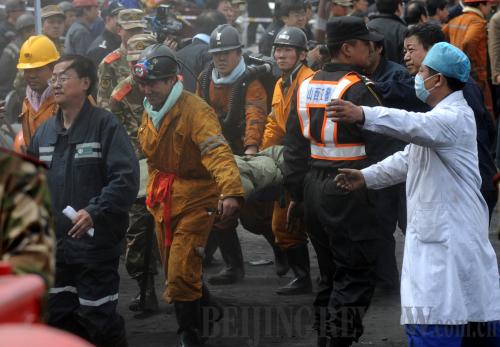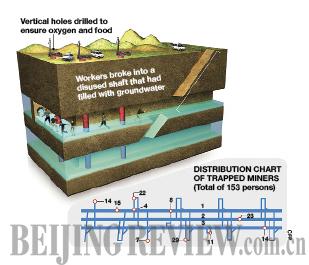|
 |
|
MOMENT OF REBIRTH: Rescuers carry survivors, who were saved from the flooded Wangjialing Coal Mine, to the waiting ambulances on April 5 (YAN YAN) |
A total of 115 workers had been miraculously retrieved from the flooded Wangjialing Coal Mine in north China's Shanxi Province by the afternoon of April 5, after being trapped underground for more than a week.
"It is a miracle in the history of Chinese mining rescues," said Luo Lin, Director of the State Administration of Work Safety, who stood waiting at the pit entrance. "The trapped miners displayed an unwavering determination to survive for eight days and eight nights."
"Scientific methods and technology used in the rescue have ensured that the miners were rescued alive," said Zhang Baoshun, Secretary of the Shanxi Provincial Committee of the Communist Party of China (CPC).
Difficult procedures
The Wangjialing Coal Mine straddles Xiangning County and Hejin City in Shanxi, a province famous for rich coal reserve and notorious for coal mine accident. The coal mine covers approximately 180 square km, and is affiliated with the state-owned Huajin Coking Coal Co. Ltd., as well as a major project approved by the National Development and Reform Commission.

At approximately 1:40 p.m. on March 28, underground water flooded into the mine after workers breached a disused shaft that had filled with groundwater, said local authorities.
A preliminary investigation showed that 261 workers were working in the pit when the flooding occurred. Of these workers, 108 were lifted safely to the surface at the start of the accident, leaving 153 workers trapped underground.
The investigation also found that the mine was still under construction and due to commence production five months ahead of schedule in October.
Fan Leisheng, one of the workers who escaped, described the sudden rush of water that tore through the mine.
"It looked like a tidal wave and I was terrified," Fan was quoted by the China Central Television (CCTV) as saying. "I immediately ran away and looked behind me to see some other workers still hanging behind. I shouted at them to get out. It was unbelievable that I managed to escape from underground."
Immediately following the accident, President Hu Jintao and Premier Wen Jiabao ordered local authorities to spare no effort in saving the trapped miners, while also guarding against secondary accidents.
The rescue headquarters were set up in the late evening of the same day, and an emergency response plan was put into operation.
In the early morning of March 29, Vice Premier Zhang Dejiang reached the site of the accident to oversee the search and rescue operation.
The water level had just stopped rising that morning, and the likelihood of survival for the trapped workers looked better, the rescue headquarters said.
On the evening of the same day, over 970 rescuers were still busy installing machines to pump water from more than 600 meters deep underground.
More than 10 pumps operating around the clock pumped up to 500 cubic meters of water per hour. Rescuers attempted to place huge pipes as long as 2,000 meter into the flood water to provide ventilation, CCTV reported.
"Pumping water out is the best way to save the trapped workers," said Sun Shouren, who was in charge of the mine's construction work.
But Liu Dezheng, a spokesman for the rescue headquarters, pointed out that complicated underground conditions could hamper the operation. "The coal mine has a high concentration of gas. Rescuers have to face the danger of toxic gas, while also fighting against the flood water."
For this reason, rescuers had started to drill a hole and open a drainage channel in the shaft to divert water from the flooded tunnel to another unaffected tunnel, he said.
| 